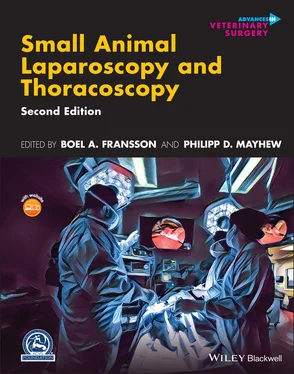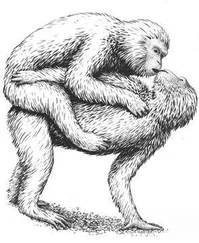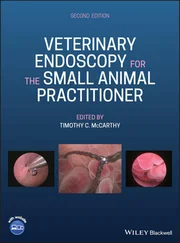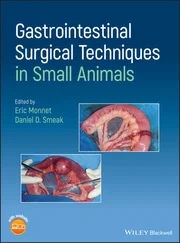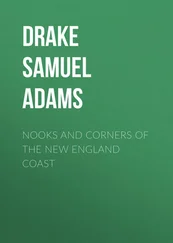35 Chapter 32Figure 32.1 Operating room layout for thoracoscopic pericardial window or su...Figure 32.2 Possible placement of the telescope for thoracoscopic pericardec...Figure 32.3 (A) Instrument port placement for thoracoscopic pericardectomy i...Figure 32.4 Alternative port positioning of the telescope and instrument por...Figure 32.5 Possible telescope and instrument portal placement for pericarde...Figure 32.6 Tenting the pericardium. With the patient in dorsal recumbency, ...Figure 32.7 Endoscopic view of heart after the subphrenic pericardectomy has...Figure 32.8 Endoscopic view of heart after pericardectomy has been achieved....Figure 32.9 In this case, grasping the pericardium was proving challenging, ...
36 Chapter 33Figure 33.1 (A) Cannula positions: paraxiphoid 5‐mm telescope cannula, right...Figure 33.2 The lead applicator is inserted via the left instrument portal; ...Figure 33.3 Lead implantation is performed in an area of the epicardium with...Figure 33.4 Incorrect insertion of the lead: the pigtail is visible; screwin...Figure 33.5 The generator is placed against the intercostal muscle as soon a...Figure 33.6 Radiography showing the correct position of the cable with one l...
37 Chapter 34Figure 34.1 Resection of a small tumor (1 cm) located on the right atrial (a...Figure 34.2 Pericardioscopy view of a tumor that is too large to be resected...Figure 34.3 Operating room layout. The dog is positioned on the rear part of...Figure 34.4 Cannula position. A paraxiphoid 5‐mm telescope cannula, operatin...Figure 34.5 Pericardial window extended cranially to increase visualization ...Figure 34.6 Atraumatic 5‐mm grasping forceps used to grasp the tip of the ri...Figure 34.7 The staples have been applied and the right atrial appendage. 5 ...Figure 34.8 The staples have been applied and the right atrial appendage wit...
38 Chapter 35Figure 35.1 Lymphangiogram depicting cisterna chyli and thoracic ducts with ...Figure 35.2 Lymphangiogram depicting thoracic duct and the classical lymphan...Figure 35.3 Representative appearance of cisterna chyli in a normal dog (A) ...Figure 35.4 The thoracic duct anatomy is highly variable between individuals...Figure 35.5 Anatomy of the dorsal thorax in a less chronically affected dog ...Figure 35.6 A preoperative CT lymphangiogram facilitates surgical planning. ...Figure 35.7 Dog positioned on the CT table and draped for popliteal lymphang...Figure 35.8 Severe fibrosing pleuritis in a dog with an eight‐month history ...Figure 35.9 Port placement for thoracic duct ligation procedure with the dog...Figure 35.10 Operating room setup for thoracic duct ligation procedure. If a...Figure 35.11 When positioning a patient for TDL in sternal recumbency, padde...Figure 35.12 Thoracic duct branches are difficult to visualize without dye i...Figure 35.13 (A‐C1) Dissection based on a preoperative CT lymphangiogram (A‐...Figure 35.14 Position of thoracic cannulas and paracostal access with wound ...Figure 35.15 Fluoroscopic lymphangiography performed intraoperatively on a d...Figure 35.16 Intraoperative image of left‐sided single port approach for cis...Figure 35.17 A subcutaneous pleural catheter‐vascular access port being plac...Figure 35.18 CT lymphangiograms obtained approximately six months postoperat...Figure 35.19 Reoccurrence of lymphatic vessels (black arrow) bypassing a pre...
39 Chapter 36Figure 36.1 Normal anatomy. Left aortic arch (LAA) with the brachiocephalic ...Figure 36.2 Vascular ring anomalies with persistent right aortic arch (PRAA)...Figure 36.3 Vascular ring anomalies without PRAA. (A) Left aortic arch (LAA)...Figure 36.4 Operating room setup for vascular ring anomaly treatment.Figure 36.5 Portal placements for vascular ring anomaly treatment. If one‐lu...Figure 36.6 Esophagram of a dog with a persistent right aortic arch and seve...Figure 36.7 Endoscopy of the esophagus. The aortic arch is on the right side...Figure 36.8 Three 5‐mm thoracoscopic cannulas with low profile. Those cannul...Figure 36.9 (A) View of the cranial part of the thoracic cavity with the dil...Figure 36.10 The ligamentum arteriosum (in the forceps) has been dissected f...Figure 36.11 Vascular clips have been placed on the ligamentum arteriosum. T...Figure 36.12 (A, B) Remaining fibers (black arrows) have been picked up from...Figure 36.13 Esophageal ballooning used to identify remaining fibrous bands ...Figure 36.14 Dorsal compression of the esophagus cranial to the ligamentum a...
40 Chapter 37Figure 37.1 Schematic transverse section of the thorax through the heart and...Figure 37.2 Thoracoscopic image demonstrating the relationship between a t...Figure 37.3 Computed tomography angiogram of a dog with a thymoma. (A) The p...Figure 37.4 Operating room setup for thoracoscopic resection of cranial medi...Figure 37.5 The recommended port positions for thoracoscopic cranial mediast...Figure 37.6 Thoracoscopic image during thymoma resection. The surgeon's fing...
41 Chapter 38Figure 38.1 Computed tomography scan demonstrating the right and left trache...Figure 38.2 Computed tomography scan demonstrating the central tracheobronch...Figure 38.3 Operating room setup for dissection of left‐sided (A) or right‐s...Figure 38.4 Port placement diagram for tracheobronchial lymph node resection...Figure 38.5 Port placement diagram for resection of sternal or cranial media...Figure 38.6 Intraoperative image demonstrating dissection of the left trache...Figure 38.7 Intraoperative image demonstrating predissection, right‐sided re...Figure 38.8 Intraoperative image demonstrating dissection of a sternal lymph...Figure 38.9 Intraoperative images demonstrating sentinel lymph node identifi...Figure 38.10 A pathologically enlarged central tracheobronchial lymph node a...
42 Chapter 39Figure 39.1 Photograph depicting the VITOM™ setup during surgery. The HD scr...Figure 39.2 Exoscope.Figure 39.3 VITOM™ setup showing the pneumatic scope holder, the Wingman (St...Figure 39.4 Exoscopy setup for a folding‐flap palatoplasty in a brachycephal...Figure 39.5 Guillotine liver biopsy in a bearded dragon using the VITOM syst...Figure 39.6 Skull with cross lines.Figure 39.7 Surgery room setup.Figure 39.8 Intraoperative view. Pneumatic scope holder, the Wingman (Stryke...Figure 39.9 Tew (KLS Martin) elongated and bayonetted neurosurgical instrume...
1 Cover Page
2 Series Page
3 Title Page Small Animal Laparoscopy and Thoracoscopy Second Edition Edited by Boel A. Fransson, DVM, PhD, Dipl. ACVS Washington State University Pullman, WA, USA Philipp D. Mayhew, BVM&S, DACVS University of California‐Davis Davis, CA, USA
4 Copyright Page
5 Contributors
6 Foreword
7 Foreword
8 Preface
9 Acknowledgment
10 About the Companion Website
11 History of Small Animal Laparoscopy and Thoracoscopy
12 Table of Contents
13 Begin Reading
14 Index
15 WILEY END USER LICENSE AGREEMENT
1 ii
2 iii
3 iv
4 vii
5 viii
6 ix
7 x
8 xi
9 xii
10 xiii
11 xv
12 xv
13 xvi
14 xvii
15 xviii
16 xix
17 1
18 3
19 4
20 5
21 6
22 7
23 8
24 9
25 10
26 11
27 12
28 13
29 14
30 15
31 16
32 17
33 18
34 19
35 20
36 21
37 22
38 23
39 24
40 25
41 26
42 27
43 29
44 31
45 32
46 33
47 34
48 35
49 36
50 37
51 38
52 39
53 40
54 41
55 42
56 43
57 44
58 45
59 46
60 47
61 48
62 49
63 50
64 51
65 52
66 53
67 54
68 55
69 56
70 57
71 58
72 59
73 60
Читать дальше
